
|
|
FYBUSH.COM/SITE OF THE WEEK
NEEDS YOUR SUPPORT! (AND YOU CAN GET A FREE TOWER SITE CALENDAR
IF YOU PLEDGE NOW...) CLICK HERE TO
LEARN MORE...
December 25, 2003 - January 1, 2004
Three Chicago Studios
It's increasingly unusual in a big city to find a radio station still in the same studio it was using two decades ago - especially if the station in question has gone from a standalone AM operation to a part of a cluster that includes two AMs and three FMs. But Chicago's WIND (560) still operates today from the very same studio on the third floor of 625 N. Michigan Avenue that it was using when your editor first visited the station in the summer of 1986 - albeit with some big changes in the interim!
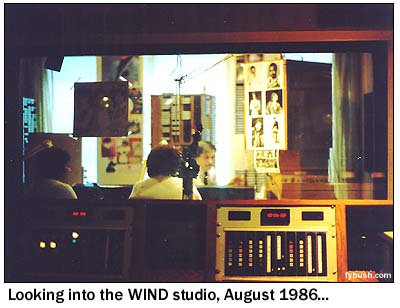 |
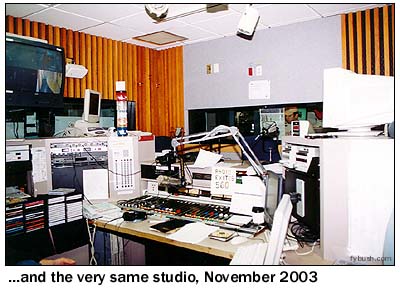 |
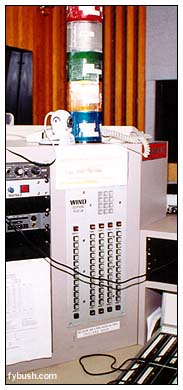 WIND's
main air studio back in 1986 still bore unmistakable traces of
the station's long history as a Westinghouse all-news outlet
for the Windy City, though by the time I stopped by it had been
sold (to the ancestor of present-day owner Univision Radio) and
had recently flipped to a format of Spanish talk and contemporary
music. The window through which I peered in 1986 is the same
one you can see above the (very same) Ward-Beck console in the
2003 photo. Today, that control room where I was standing is
the compact air studio for "Viva" WVIV-FM (103.1 Highland
Park)/WVIX (93.5 Joliet), while WIND continues to operate from
the much larger studio in the foreground, running a Spanish hits
format as "Radio Exitos 560."
WIND's
main air studio back in 1986 still bore unmistakable traces of
the station's long history as a Westinghouse all-news outlet
for the Windy City, though by the time I stopped by it had been
sold (to the ancestor of present-day owner Univision Radio) and
had recently flipped to a format of Spanish talk and contemporary
music. The window through which I peered in 1986 is the same
one you can see above the (very same) Ward-Beck console in the
2003 photo. Today, that control room where I was standing is
the compact air studio for "Viva" WVIV-FM (103.1 Highland
Park)/WVIX (93.5 Joliet), while WIND continues to operate from
the much larger studio in the foreground, running a Spanish hits
format as "Radio Exitos 560."
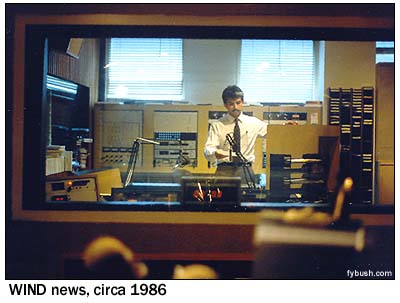 The
format is the result of a very recent (as in just
weeks prior to my visit) set of format flips that moved WIND's
"La Tremenda" Spanish news-talk format up the dial
to AM 1200, which had been doing regional Mexican as WLXX and
then had been simulcasting "Viva" as WVIV, and is now
running under the WRTO calls.
The
format is the result of a very recent (as in just
weeks prior to my visit) set of format flips that moved WIND's
"La Tremenda" Spanish news-talk format up the dial
to AM 1200, which had been doing regional Mexican as WLXX and
then had been simulcasting "Viva" as WVIV, and is now
running under the WRTO calls.
In addition to the Ward-Beck console, a few other vestiges of the Westinghouse era still survive in today's WIND studio - check out that phone panel next to the board, a cousin to the ones in the control room in that 1986 photo. (You've gotta love that neat stack of warning lights above the phone panel, too - everything from the doorbell to the silence sensor to the EAS alert seems to have a light there!)
At left is another photo snapped during my 1986 visit, of a room that I have marked in my photo album as "newsroom." I'm not sure that's really what it was (the newsroom from the Westinghouse all-news era is now a promotions office at the end of the hallway that holds all the Univision Radio studios) - in all likelihood, this is actually the room that's now, after much renovation, the studio for WRTO. Or perhaps it's the studio at the other end of the hall that's now "La Que Buena" WOJO (105.1 Evanston), the legacy Spanish-language FM that was still operating separately from WIND in 1986, with studios on Main Street up in Evanston itself. I think it's the former, but so much has changed in 17 years that it's hard to tell.
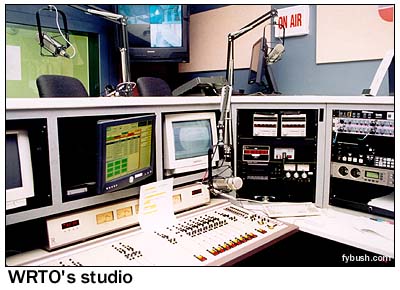 |
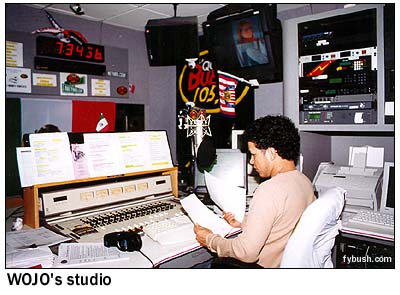 |
I'm somewhat more certain that the room in the middle of this long hallway where I photographed the guts of the WIND technical operation, circa 1986, is the same one that's still home to the guts of Univision Radio in 2003. Of course, the nature of those guts has changed immensely in two decades - there were no servers, ISDN codecs, digital processors or EAS boxes in 1986 - and there's certainly no reel-to-reel logging or spaghetti patch panel to be seen now. (And any former Westinghouse all-news radio staffer, like your editor, knows exactly what those car radios are doing in the rack second from right in the 1986 photo - they're the air monitors feeding the all-important competition to the editor's desk in the newsroom! Back then, they'd almost certainly have been tuned to WMAQ 670, WGN 720, WBBM 780, WLS 890, WCFL 1000 and WJJD 1160.)
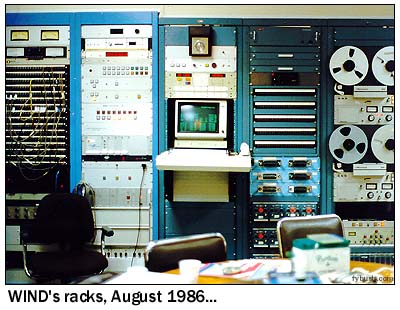 |
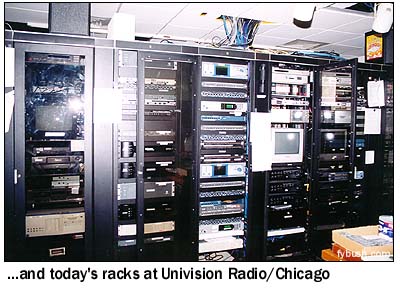 |
Our visit to the Univision studios capped a very long day of radio tourism that started at about 8:00 Central time down in Valparaiso, Indiana and finally wrapped up some 13 hours later with this tour - and with copious thanks to Univision Radio/Chicago chief engineer Paul Easter, who was our tour guide par excellence for most of the day.
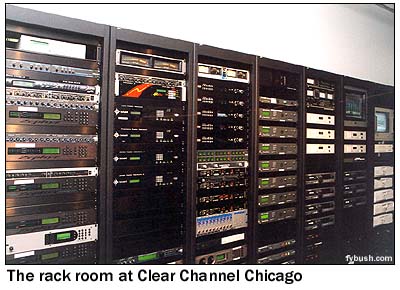 |
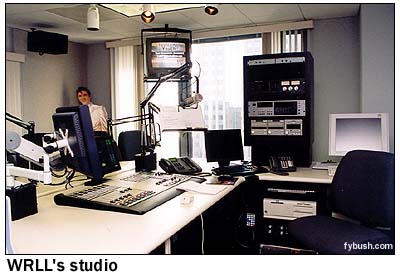 |
Our Chicago radio visits were far from over, though. The next morning found us back in downtown Chicago, checking out the new studio that consolidates the facilities of all seven Clear Channel radio stations in market #3.
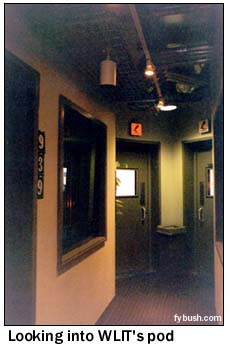
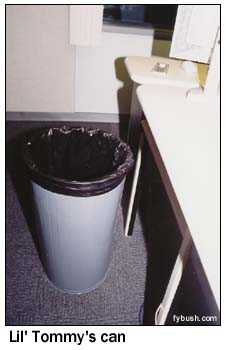 Black gospel WGCI
(1390), AC WLIT (93.9), smooth jazz WNUA (95.5), urban contemporary
WVAZ (102.7 Oak Park), top 40 WKSC (103.5), R&B WGCI-FM (107.5)
and the newest addition, "Real Oldies" WRLL (1690 Berwyn)
all share two floors of the Illinois Center building at 233 N.
Michigan, in a facility they've occupied for less than a year.
The rack room shown above has seven of almost everything, from
the Prophet NexGen audio storage and automation system to air
monitors to EAS units - even CD burners for talent to use to
aircheck themselves.
Black gospel WGCI
(1390), AC WLIT (93.9), smooth jazz WNUA (95.5), urban contemporary
WVAZ (102.7 Oak Park), top 40 WKSC (103.5), R&B WGCI-FM (107.5)
and the newest addition, "Real Oldies" WRLL (1690 Berwyn)
all share two floors of the Illinois Center building at 233 N.
Michigan, in a facility they've occupied for less than a year.
The rack room shown above has seven of almost everything, from
the Prophet NexGen audio storage and automation system to air
monitors to EAS units - even CD burners for talent to use to
aircheck themselves.
Each of the seven stations has its own "pod" of studios off the U-shaped main hallway. The pod of WLIT, at left, is typical - two main air studios at the end of the hallway (each substantially identical to the WRLL studio above), a production studio (at left) and a smaller studio that can be used as a news booth, a voicetracking booth or (in one pod) for traffic reports.
WRLL's main studio has one unusual feature (in addition to the Elvis cutout standing guard in the corner) - a big metal trash can with a few telltale dents in its walls. The trashcan is a regular sound effect of Larry Lujack and "Lil' Tommy" Edwards' morning show, and when the duo returned to the air on WRLL, we're told they prowled the aisles of a Chicagoland hardware store testing the cans until they found one with just the right sound.
Our visit at Clear Channel is a brief one, though, for our schedule next calls for a visit to another nearby Michigan Avenue office tower and an appointment with one of the most famous radio studios in America.
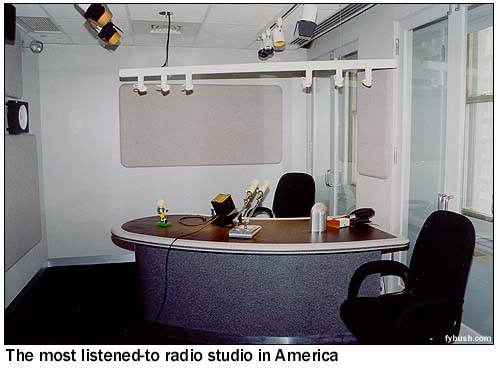
This utterly unassuming room on the 16th floor is, we believe, the most listened-to radio studio in the nation, for it's here that Paul Harvey speaks to America and the world three times daily. It doesn't get much simpler, does it? Two Electro-Voice RE20 mikes, a monitor speaker and the clock on the wall pretty much sum up the gear, and the decorations are limited to a glass case on the floor that holds the dozens of keys that Mr. Harvey has been given to cities and towns around the country.
But when Mr. Harvey sits down and, on the cue from his engineer (out of frame through a window to the left of the clock), launches into "Hello, Americans...", there are few experiences that can compare to being in the studio when the master is practicing his art. I think I may have breathed once or twice during the 15-minute midday newscast (fed from here at 10:35 AM CT), but it's hard to remember in all the excitement.
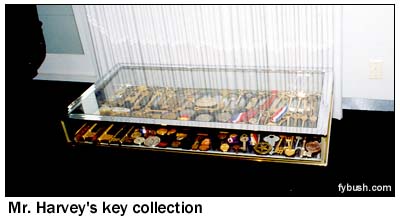 |
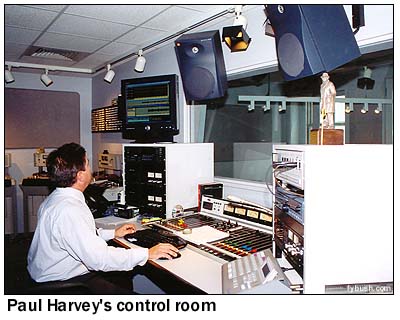 |
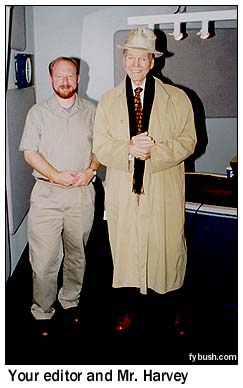 After
the newscast is over (and with it, Mr. Harvey's day - he comes
in at 4 AM, writes both his daily broadcasts himself, and is
on his way home after a few quick retakes of several words in
the midday newscast), we're treated to a brief tour of the comfortable
office suite in which the Paul Harvey News staff works. While
the control room still houses four big Otari reel-to-reel machines,
the broadcasts are now edited digitally to be refed to ABC in
New York and then to the hundreds of affiliates around the country.
After
the newscast is over (and with it, Mr. Harvey's day - he comes
in at 4 AM, writes both his daily broadcasts himself, and is
on his way home after a few quick retakes of several words in
the midday newscast), we're treated to a brief tour of the comfortable
office suite in which the Paul Harvey News staff works. While
the control room still houses four big Otari reel-to-reel machines,
the broadcasts are now edited digitally to be refed to ABC in
New York and then to the hundreds of affiliates around the country.
A conference room looks into the studio; it's used for greeting visitors (including my companion for this tour, Blaine Thompson of Indiana Radio Watch fame, for whom Mr. Harvey has several questions about Fort Wayne and about his affiliate there, WOWO.)
Down the hall are offices for the staff, for Mr. Harvey himself and for his wife, Angel, who still comes to the office from time to time. (We can attest, having seen it personally, that the Paul Harvey newscasts are still typed on an IBM Selectric typewriter by the man himself.)
It's a pleasure to report that Paul Harvey himself is every bit as gracious and accommodating in his studio as he sounds on the air - and that, at 85, he's still the picture of good health. (And it was a pleasure to be able to thank him in person for saying such nice things about the Tower Site Calendar last year...and to learn that his engineer reads some of your humble scribe's writings from time to time!)
One more thing before we leave the Paul Harvey News studios and make our way over to the nation's tallest building for a quick transmitter tour. Have you ever wondered what the receptionist at Paul Harvey News says to visitors as they leave? What else - "Good day!"
Which it is - and it's about to get even better. Next week on Tower Site of the Week, we head up the Sears Tower, have an informative lunch, and head out to a legendary transmitter site in the suburbs...
Tower Site Calendar 2004 is NOW SHIPPING! All orders placed by Wednesday, December 24 have now been shipped - and if you haven't yet ordered, what are you waiting for? Click here for ordering information!
- Previous Site of the Week: John Hancock Center, Chicago (now with added historical information!)
- Next Week: WGN 720, Chicago
- Site of the Week INDEX!
- How can you help support Site of the Week? Click here!
- Submit your suggestions for a future Site of the Week!
